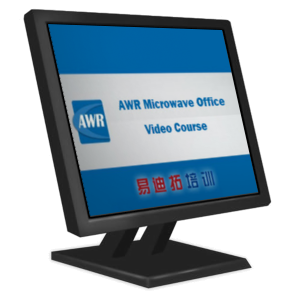- 易迪拓培训,专注于微波、射频、天线设计工程师的培养
Ports in Analog Office
What are ports in Analog Office and do I have to use them?
There are various port elements in Analog Office. Understanding their purpose and proper use will greatly speed your familiarity with Analog Office, especially if you are coming from a Cadence/SPICE background.
BACKGROUND
At RF and microwave frequencies, the distinct concepts of voltage and current become cloudy because there is usually no way to measure them without changing the circuit's performance. As a result, measurements at these frequencies have traditionally been performed using power instead of voltage and/or current because power can be measured with instruments that have very well matched, broadband inputs (vector and scalar network analyzers, power meters, spectrum analyzers, etc.). Analog Office includes many types of ports that can be used as either sources or as loads (terminations). The various types of ports will be discussed below. Note that all ports are set by default to a 50 Ohm impedance.
PORT
The PORT element is the most commonly used port. It provides the following functionality:
In hierarchical projects, a PORT element provides the interconnectivity between a lower level schematic and its next high level schematic. When PORT is used in this manner, to provide subcircuit connectivity, the impedance ("Z") parameter is ignored. It provides connectivity only. In this case, PORT is like a Cadence "terminal". Note also that explicit loads are not used for subcircuits in Analog Office. Simply attach a PORT where you want to make the higher level connection.
When used in a LINEAR top level schematic, PORT provides signal I/O points. Linear measurements can be made at these ports, such as S-Parameters, noise figure, stability, etc. When used as a signal source, the impedance ("Z") parameter is used to set the source impedance and the power is simply assumed to be low enough that the circuit behaves in a linear fashion. When used as a load, or termination, the impedance ("Z") parameter sets the impedance to ground at that point and provides a measurement point as well. Absolute measurements (power, voltage, current) can not be made with linear analysis. Note also that linear ports have an implicit ability to both send and receive power, so a measurement like S22 allows the reflected power to be separated from the incident power and measured directly at the PORT.
When used in a NONLINEAR analysis, we have to make the distinction between sources and loads. PORT provides a load for any nonlinear measurement, but it does not provide any nonlinear source capability. PORT can be used to perform linear measurements on nonlinear circuits but it can not drive any nonlinear measurements.
ALL OTHER PORTS
All remaining ports are nonlinear source ports. Their individual function can be found by searching the help for "PORT". All port names begin with "PORT", so they are all grouped in the help, making it easy to compare different elements. There are both single tone and two tone ports, there are ports that have specific waveforms associated with them, and there are ports that can provide modulated signals to the circuit. There are also waveform sources that look and behave more like traditional SPICE sources. Finally, there is a user configurable port that can behave as defined by the user - this single element (PORT_SRC) can perform as any of the other types of ports or it can be configured as needed.
Overall, there are decisions to be made in terms of the various port capabilities and the discrete voltage/current sources.
DO I HAVE TO USE PORTS?
The short answer is no for top level schematics and yes for subcircuits in hierarchy. Ports are the only way to establish subcircuit connectivity for higher schematic levels. Voltage and current sources can be used at the top level and they will behave as expected. There are, however, many features available in Analog Office that are simplified by using ports.
SHOULD I WANT TO USE PORTS?
We believe the answer is yes. Power measurements and the ability to sweep power are made much easier by using ports. Two tone excitations are trivialized by using a two tone port, and the ability to sweep the offset between the two tones is parameterized. These are just a few examples of the types of measurements that are simplified with the use of ports.
AWR Microwave Office 培训课程套装,视频教学,帮助您快速学习掌握MWO...
上一篇:Printed Circuit Board (PCB) Layout Application Note
下一篇:NXP LDMOS (previously Freescale) Models Do Not Simulate Correctly
 Microwave office专业系统的视频培训套装,帮助您从零开始,全面学习MWO的设计应用【More..】
Microwave office专业系统的视频培训套装,帮助您从零开始,全面学习MWO的设计应用【More..】
频道总排行
- Which CPW Line Models Support
- Problem Saving Layout Rulers in
- Calculate 3dB Bandwidth of Band
- AWR&'s GERBER File Format Details
- Using DXF Format with the AWR
- DXF Files Do Not Open in AutoCAD
- FAQ: Using Encrypted HSPICE Netlists
- Touchstone File Repair Utility
- How Can I Fix the Shorted Cir
- Failure initializing the AWR Sc
